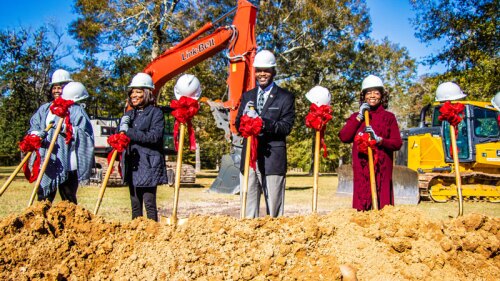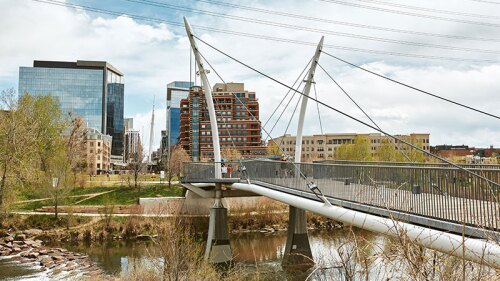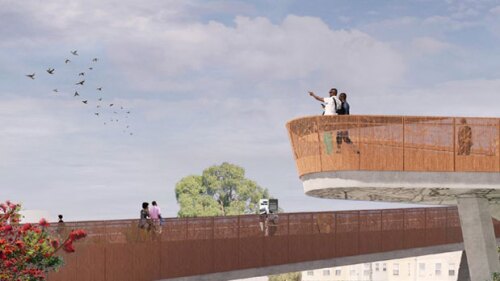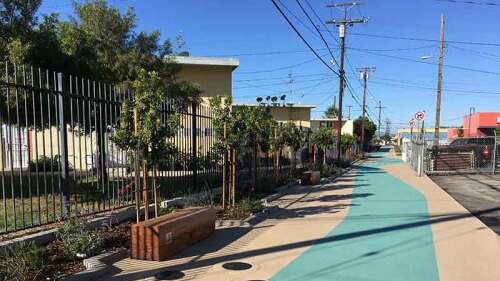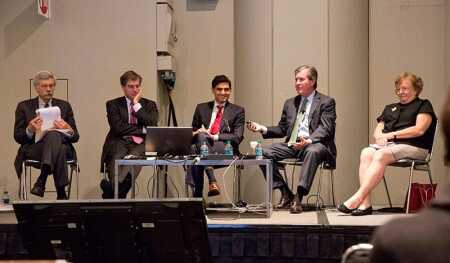
From left: Peter Harnik, director of the Trust for Public Land’s Center for City Park Excellence; Daniel A. Biederman, president, 34th Street Partnership/Bryant Park Corporation; moderator Ommeed Sathe, director, social investments, Prudential Real Estate; John L. Zogg Jr., managing director, Crescent Real Estate Equities and Tupper Thomas, executive director, New Yorkers for Parks, speaking during a concurrent session at the Fall Meeting in New York City.
“I don’t often speak in hyperbole like some of our friends here, but I will be the first to say that when it comes to public parks today, America is entering a golden age,” commented Peter Harnik, director of the Trust for Public Land’s Center for City Park Excellence, in remarks to attendees of the ULI Fall Meeting. A golden age for parks often translates to gilded surroundings, according to the participants on the panel “Green from Green: Creating Real Estate Value from Private Management of the Public Realm.”
Parks conservancies and, more recently, park improvement districts initially stepped into the breach of public neglect during the 1980s, directing private resources to the maintenance of often-neglected public parks. Their model soon spread, as neighbors realized their utility both as a means of reducing nearby crime and soon of leveraging increased value and utility out of a park’s surroundings.
Tupper Thomas, executive director of New Yorkers for Parks and former head of the Prospect Park Alliance, noted that “the park block either is very good for your property or not so good for your property.” In the case of Prospect Park and most cases under discussion on the panel, the park block was decidedly not so good.
The panelists offered a variety of lessons and experiences from assorted urban park experiences (in Newark, New Jersey; midtown Manhattan; Brooklyn; and Dallas) about how parks can not merely be improved, but can also serve as tangible assets and sources of value to nearby property owners and communities.
Daniel A. Biederman, president of the 34th Street Partnership/Bryant Park Corporation, outlined his ten years of work on the redevelopment of Bryant Park, which, despite its prime location in midtown Manhattan, was plagued well in the 1980s by litter, graffiti, drug sales, and the “universal symbol of the [New York] parks department in the 1980s, which was an oil drum serving as a trashcan.” He noted that “I’m going to take you through a battle I have, which is convincing property owners in Manhattan and elsewhere that they’re better off investing money in the park across the street instead of in their building.”
His early realization—at a point when the Bryant Park Corporation had few resources—was the central importance of activity to keeping the park free from drug and crime activity. His aim was “low design, high programming,” which was rapidly carried out with a plethora of activities ranging from the seasonal ice rink to square dancing, bluegrass, Ping-Pong, a singles’ bar (“the singles don’t go home at six; they stay around forever”), modern dance, mass yoga, outdoor movies, and more. Activity begat safety as well as both increasing revenue for the park and for owners nearby. The owners of the Grace Building across the street on 42nd Street donated some $3 million to the park over a period in which they’ve seen an increase in effective rents of $15 per square foot ($161 per sq m), and an according rise in their annual rent roll of 19.5 percent. This, he observed, is a much greater award than working on your lobby or buying a Jeff Koons sculpture. Rents in the district directly surrounding Bryant Park have reliably risen higher than those in other adjacent midtown districts.
Ommeed Sathe, director of social investments for Prudential Real Estate, outlined his similar experience of work renovating Military Park in downtown Newark. The park, like Bryant Park, was recently an open-air drug market, surrounded by a city in much worse health than New York. Prudential, one of whose new buildings is located on the park, saw the value of public investment and spearheaded both the renovation of the park and of another adjacent former department store (soon to house a Whole Foods). Again, Prudential’s goal was not so much capital improvements as operations; the initial renovation, which included the installation of reading and play areas and a variety of other attractions, cost $3 million. The park’s yearly operating expenses come to $1 million, and Sathe suggested that this was an ideal balance.
Thomas recounted her experiences working with the Prospect Park Alliance in Brooklyn, a far larger park, and one with virtually no corporate neighbors. It was, in the 1980s, a “fabulous asset in the middle of a neighborhood that was not going to use it.” She recalled an initial statistic that its 580 acres (235 ha) received only 1.7 million annual visits, in a park whose center was virtually unused.
She wielded a combination of federal, state, and city resources in the pursuit of initial renovations, stressing the importance of “an enormous amount of commitment from the city first before it could attract private attention.” Once this was accomplished, however, the Prospect Park Alliance rapidly took off, building from $200,000 worth of funding in its first year to a current annual operating budget of over $7 million. The process has resulted both in an improved asset and one for which the city is relieved of much financial responsibility for maintaining. It has turned those “park blocks” into immensely valuable assets, but has offered a much greater benefit to the neighborhoods of many different income ranges that surround the park. As Thomas commented, “In talking about green for green, it shouldn’t be just green money which is immediately popular, but also what you’re serving to your community.”
In discussing successful private park management, Peter Harnik, director of the Trust for Public Land’s Center for City Park Excellence, itemized a lengthy list of benefits both financial and more spiritual gained from city parks: They reduce air and water pollution; they offer recreational assets from swimming pools to tennis courts that residents would have to pay for elsewhere; they offer the health benefits of a convenient location for exercise; and they offer the revenue of tourism, and—highly significant—the concrete benefit of increased nearby property values. Often, these benefits are obtained simply by public agencies; the public sector provides $6.2 billion in park funding, but conservancies have played an increasing role, with some $165 million in revenue a year, and a scope that has spread from a northeastern start southward and then westward to Atlanta, Houston, and St. Louis
Harnik suggested that this spread might also encourage Eastern Seaboard notions of park-adjacent density, transit-oriented development, and park-oriented development. Parks are a natural means of improving nearby neighborhoods; they might also spur development. Cities could “use the parks as nodes for smart growth,” he said.
Klyde Warren Park in Dallas—the freeway-capping winner of the Urban Land Institute’s 2014 Urban Open Space Award—is another such case of southward migration of the use of parks as means to leverage value out of surrounding neighborhoods. Only in this case there was no park to improve, only a highway splitting Dallas’s downtown from its burgeoning arts district. John Zogg Jr., managing director of Crescent Real Estate Equities and a prominent partner behind the development of the park, notes that after initially visiting the mayor to suggest a park cap, he confided, “We all laughed at you after you left; we thought it was the stupidest idea we’d ever heard.” Nonetheless, park backers persevered through seven years of effort to a multiblock park—which has replaced, in Zogg’s words, a “noose” with both a community asset and connective tissue—which has ushered in both new neighborhood activity and a rise in nearby rents.
Panelists advised that there are risks. Private park management is a means to improve parks, but users should take caution that it does not exclude or marginalize users. In an age in which parks are a very concrete incentive to neighborhood improvement, perhaps, Thomas asked, should the question be about all parks? As Thomas observed, “Gentrification happens because not enough parks are well maintained and beautiful.” One hopeful solution? That “all parks should be well funded.”

